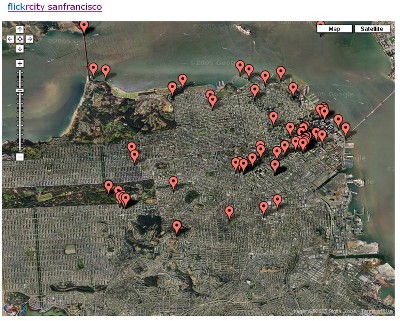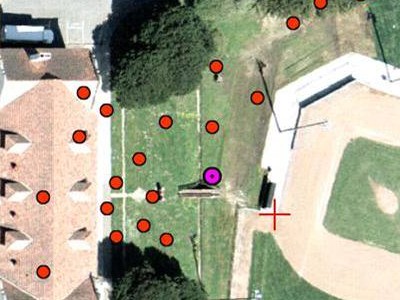January 26, 2006
everyware
I'm looking forward to Adam Greenfield's forthcoming book Everyware. Mark the date, February 17, 2006, and be there. In the meanwhile, have a read of this nice interview with Adam.
Ubicomp is far more than “smart” objects, which might be best regarded as a symptom of a deeper paradigm just now unfolding. For me, it’s fundamentally about the surfacing of information that has always been latent in our lives; pattern recognition and machine inference based on large amounts of such information; and about the domain and scale of technical mediation contemplated - both wider and narrower, higher and lower than has been the case previously.
Mmm, mmm, good. And hey Alex, don't you think "everyware" is a pretty decent word, post-cyberspace-wise? I can almost, almost imagine a Gibson book by that name. On second thought, it would be a no-brainer for Rucker. Eh, never mind, Adam has beat them both tuit.
January 25, 2006
"cyberspace" is dead?
Congratulations to IFTF researchers Alex Pang and David Pescovitz on getting an article into the latest Wired ("Cyberspace" Is Dead, Wired 14.02, February 2006). Good on you, gents! This is an outgrowth of the research Alex has been blogging about over at The End of Cyberspace, which you should definitely be reading. In the Wired piece, they asked various thinkers and doers to come up with a better term than "cyberspace" to describe the "world of smart objects, always-on devices, and perpetually open information channels" that we live in. Here's what they got, along with my own snarky editorial commentary:
Steve Jurvetson: "Augmented reality. In competition with virtual worlds and AIs, we will coevolve and internalize technologies to augment reality and our intelligence."
Me: Huh? Okay, so it's a cyberspace (oops!) tag team smackdown pitting us Borg against The Architect and the Tessier-Ashpool cores? Whoa. Anyway AR means something already, and as street jargon it just doesn't roll off the tongue.
Vint Cerf: "I still like [Xerox PARC researcher] Mark Weiser's term ubiquitous computing. It's a world in which the computer would melt into the walls and furniture."
Me: Big, big fan of Weiser's vision. Ubicomp is definitely part of it, but it doesn't cover all the stuff that happens "inside" the network, like MMOGs. Plus, anything that has the word "computing" in it is a non-starter for everyman.
Paul McFedries: "The combination of ubiquity and necessity makes the Net analogous to an atmosphere. I think the replacement word ought to be a play on that: infosphere."
Me: Good effort by the neologist behind wonderful Word Spy, but no cigar IMHO. "info" is too narrow, at least in its common usage, and it misses the physical component entirely. Anyway, just try to say infosphere three times fast, bleah.
Katy Borner: "A global brain, dominated by implants that merge biological creativity with digital resources and speed."
Me: Katy, meet Steve, sounds like you would be good together. But I don't think we're talking about the singularity here, at least not yet.
Neil Gershenfeld: "I'd vote for calling it the world. Information technologies are finally growing up, so we can interact with them in our world instead of theirs."
Me: Ah, Neil you brilliant dreamer. I really like the sentiment, but for most of us plain folk technology is not yet a normal, invisible, accepted part the world we live in. Besides, what fun is it if there's no cool new jargon to describe our cool new existence?
Ross Mayfield (from the EoC blog): on, catalink.
Me: I love "on", because it works really well with "onject"! But I think it falls short because it mostly describes the state of presence ("I'm on") and not the rest of the stuff (flickr, ambient displays, MMOGs, sensornets, etc). Catalink is superbly well-intentioned but esthetically catatonic, sorry.
Notably, Gibson said that the term he originally coined is now "past its sell-by", but he couldn't come up with a better one either.
Okay, so it's easy to be a critic and hard to come up with great neologisms. I'll get to work on that next. In the meanwhile, thanks to Alex, David & their luminarians for stirring the pot with this thought-provoking piece.
January 06, 2006
supporting interspecies social awareness
Just got my copy of the UIST 2005 proceedings, and was rather amused to find this paper by Mankoff, Dey et al: Supporting interspecies social awareness: using peripheral displays for distributed pack awareness.
In interspecies households, it is common for the non homo sapien members to be isolated and ignored for many hours each day when humans are out of the house or working. For pack animals, such as canines, information about a pack member's extended pack interactions (outside of the nuclear household) could help to mitigate this social isolation. We have developed a Pack Activity Watch System: Allowing Broad Interspecies Love In Telecommunication with Internet-Enabled Sociability (PAWSABILITIES) for helping to support remote awareness of social activities. Our work focuses on canine companions, and includes, pawticipatory design, labradory tests, and canid camera monitoring.



On the Internet, nobody knows your lead author is a dog. As for peer review... well, let's just not go there ;-)
October 09, 2005
placecasting
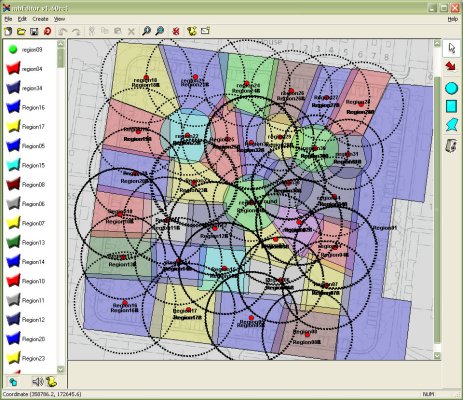
'placecasting': networked publishing of digital media (esp. audio) that is logically associated with a physical location, to be experienced by suitably equipped people in that location. See also mediascapes.
www.mobilebristol.com
Scape the Hood
"Magic Moments in Situated Mediascapes", Reid, Hull, Cater and Fleuriot 2005.
UPDATE 10/12/05: SmartMobs picks up Scape the Hood
printable hyperlinks
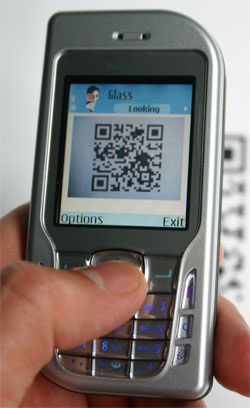
Putting the Ink in Link
In my web 2.0 talk, I discussed printable hyperlinks and the active print project. The prototype phone client 'Glass' that decodes QR and datamatrix codes is available as a download for series 60 cameraphones. You can also generate your own codes.
This project and related others point to a world where arbitrary physical objects can be linked to web services, which can be launched with the click of a mobile phone. Of course, this is already a big deal in Japan. There's even a QR code blog ;-) Apparently Korea has a similar ColorCode as well. It's just amazing how far behind the US is falling in mobility...
September 24, 2005
brilliantly creepy dermal display
This is too brilliant/funny/weird for words. Artist "nanogirl" made a startling visualization of a "dermal display". It's a big QT download, but well worth your bandwidth. And see if you don't LOL twice, right around 20 seconds in ;-)
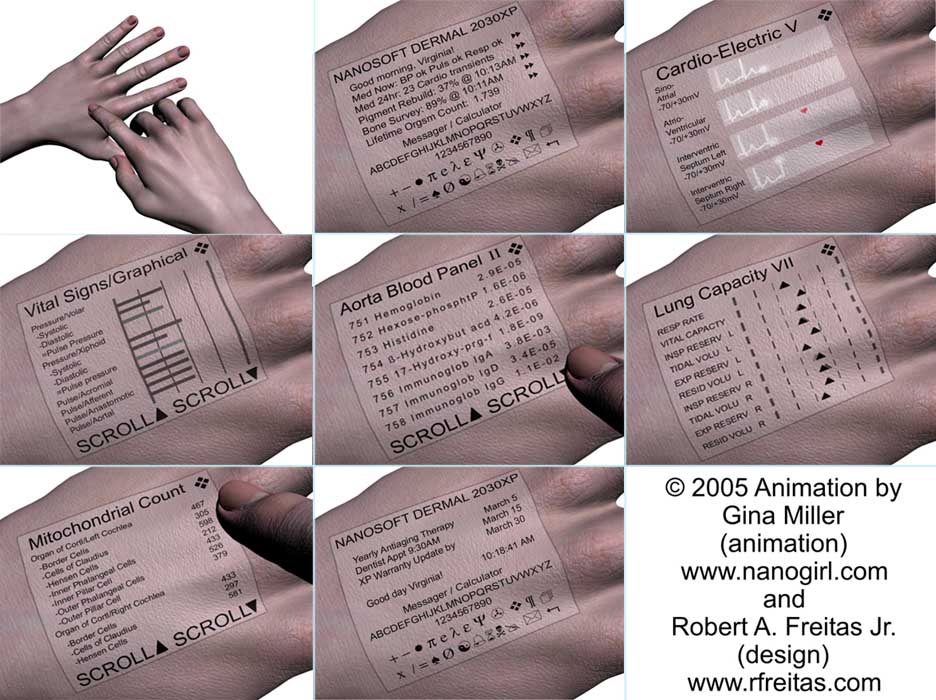
In his book Nanomedicine, Volume I: Basic Capabilities [available on the web at http://www.nanomedicine.com/NMI.htm ], Robert A. Freitas Jr. describes [in section 7.4.6.7 (page 204)] a "programmable dermal display" in which a population of about 3 billion display pixel robots would be permanently implanted a fraction of a mm under the surface of the skin, covering a rectangle 6 cm x 5 cm on the back of the hand. Photons emitted by these pixel bots would produce an image on the surface of the skin. This pixelbot array could be programmed to form any of many thousands of displays. Each display would be capable of two functions: (1) presenting to the user data received from the large population of medical bots that roam the user's body; (2) conveying instructions from the user to that same large population of bots. The display could be activated or deactivated by finger tapping on the skin.
Kind of lends new meaning to "skinning" your display. So what dermal theme will you be running?
[via kurzweilai.net]
August 12, 2005
ubicomp and media mixes
While we're at it, here's another nice Mimi thing: Technologies of the Childhood Imagination: Yugioh, Media Mixes, and Everyday Cultural Production. I'm glad to see this is going to be published, as it points to a very important (in my opinion) parallel between multi-channel social media phenomena and ubiquitous computing.
The imagination of Yugioh pervades the everyday settings of childhood as it is channeled through these portable and intimate media forms. These forms of play are one part of a broader set of shifts towards intimate and portable technologies that enable lightweight imaginative sharing between people going about their everyday business. In many ways, this ecology is an illustration of concepts of ubiquitous or pervasive computing (Dourish 2001; McCullough 2004; Weiser 1991; Weiser and Brown 1996), extended to popular culture. In Japan, this pervasive media ecology includes trading cards, portable game devices, “character goods” such as mobile phone straps and clothing, screens and signage in the urban environment, as well as multimedia mobile phones that capture and exchange visual as well as textual information (Ito 2003; Okabe and Ito 2003). Imaginative fantasy is now more than ever part of the semiotics of everyday social life.
Yugioh, Pokemon, the Star Wars universe and their ilk are the early heralds of an age of ubiquitous media, or ubimedia. These media mixes, richly entwined with social and cultural practices, provide a useful context for understanding "what is the question to which 'ubicomp' is the best answer?"
personal, portable, pedestrian
Mizuko Ito's new book (edited with Daisuke Okabe & Misa Matsuda) , Personal, Portable, Pedestrian: Mobile Phones in Japanese Life, is a collection of research papers and chapters focused on social and cultural integration of keitai in Japan. Happily, the editors' work is well represented in the text.
From the introduction:
In contrast to “the cellular phone” of the US (defined by technical infrastructure), and “the mobile” of the UK (defined by the untethering from fixed location) (Kotamraju & Wakeford 2002), the Japanese term, “keitai” (roughly translated, "something you carry with you”), references a somewhat different set of dimensions. A keitai is not so much about a new technical capability or freedom of motion, but about a snug and intimate technosocial tethering, a personal device supporting communications that are a constant, lightweight, and mundane presence in everyday life.
Mimi's work in this field has been consistently insightful, and has strongly informed the way I think about social media technologies. Time to head over to amazon, folks.
July 06, 2005
May 18, 2005
playing flickr
Over at mediamatic.net (always worth watching, these folks are) they are featuring playing FLICKR, an installation in Amsterdam club/restaurant 11 where you can SMS a flickr tag and the resulting image streams are shown on big screens mounted all around the restaurant and dance floor:

And what is the name of the emerging genre that this is an example of? Social situated mobile media? Would that be "SoSiMoMe", or just SoMo for short?
[See also: flickr peep show and mediamatic mobtagging salon]
March 07, 2005
i really want to like my SPOT watch
I have the Swatch Paparazzi, and I have been using it on and off for about 3 months. I really have tried to like this thing, but frankly it is just not very interesting. It feels like the SPOT/MSN Direct team took their inspiration from a bad vision of the information superhighway, circa 1995. The services offered (news, weather, stocks, movie schedules, horoscopes, Swatch City local events) are tiny toy versions of services I get on my phone and on the Net, so there's almost no incentive to look at them on the watch, except for the novelty factor or when I am truly, deeply bored. Since SPOT uses a broadcast model for distributing information, there's zero interactivity or social connectivity. And unless I've missed it, there's no way to make interesting personal content for the watch (graphics, tones etc). So let's see, that's three strikes, and here in California we know what that means. Guess we'll have to wait for version 3.0 on this SPOT thing...
Oh, but I do like the different animated watch faces. That part is fun, and I give credit to the Swatch folks for doing what they do well.
Here's an extended journal by Scott Weinman, a veterinarian who used a SPOT watch as part of an MBA class at Seattle University. He doesn't like it much, either.
March 04, 2005
mapping blogs with mappoint
MapPoint developer Chandu Thota is doing a fun geolocation thing called blogmap. Kind of like geoURL, but with a serious mapping service under the hood. Here's my neighbloghood. Doesn't appear to work right in Firefox, unfortunately; try it in IE to see the full effect.
You know I love and believe in this stuff. But folks, it's time to start thinking standards and layered abstractions for geolocation application services. Let's don't have mapping engines like MapPoint and Google Maps become proprietary lock-in platforms, please. That's so 20th century.
[via scoble]
UPDATE: Jon Udell finds open goodness in Google Maps. w00t!
EVEN MORE: engadget shows us how to make your own annotated multimedia Google map. Uber cool.
March 01, 2005
so where's my ubi-museum browser?
SFMOMA has a nice website up that complements the current retrospective exhibit of Robert Bechtle's work, adding depth, color and context to the artworks on display. I'm going to load it up on my tablet PC and bring it with me to the gallery.
And then I'm going to wish they had wifi in the museum so I could just browse it directly, and that they made rich contextual media to go with *all* of their collections, and that I could have it all just happen when I'm standing in front of the art. Oh wait, we've been talking about this for years, so why am I still wishing?
I have long believed that a web-augmented reality would be broadly useful in the world, but that it would emerge first in the museum community, where content, curation, and containment made it easier to get started. Well here we are in 2005; wifi is cheap, mobile gadgets are everywhere, web designers will work for food, and art isn't dead yet. So what's it going to take, to get this simplest of ubicomp services to fly?
February 16, 2005
gps tracklog storytelling
Here's a new and interesting GPS + photos + stories app to try out: Magnalox ("magnificent logs" ;-). It's rather delightfully geeky, as evidenced by 1) the detailed graphs of altitude and velocity displayed next to the location trace, and 2) the first magnalog example carries a clever message:
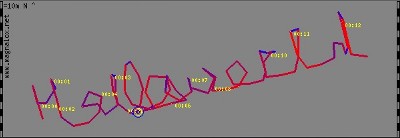
Hey Volker, it's cool! Have you looked at integrating this with google maps, a la Glen's movin gmap?
January 27, 2005
move over Ma Bell, here comes Ma Bezos
Presumably you've seen the new A9 yellow pages search, which is enhanced with photographs of the resulting address locations (currently covers 10 US cities)? It's pretty cool, and I love the geeky audacity of them actually driving around all the commercial streets of several large metro areas taking photographs every few meters. But the part that really got my attention was the potential for this to turn into a large scale distributed cooperation effort, where business owners, customers, and other interested parties shared their own photos, information, reviews, RSS feeds, and sundry metadata to turn the humble yellow pages into a vast, living, er... conversation... about the (commercial) world. Don't like the picture that comes up next to your store's listing? Upload a better one. Had a great meal at that restaurant? Write your review (and textit/post it from your favorite location-enabled mobile blogging device ;-). A9 only drove 10 cities? No worries, we'll take care of the rest.
Hey A9 team: how about supporting RSS feeds and trackbacks for the YP search results? That could be a lot of fun, and I'm pretty sure there's an interesting value proposition for the businesses in your listings.
[via AndyF-who-needs-to-get-an-outside-blog-so-I-can-ping-him]
December 08, 2004
the twelve days of ubi-christmas
On the twelfth day of Christmas, my research lab gave to me...
Twelve active badges
Eleven sensor networks
Ten wireless beacons
Nine memory prosthetics
Eight tangible interfaces
Seven smart home testbeds
Six virtual street games
Five ambient displays
Four healthcare monitors
Three museum guides
Two smart fabrics
and an RFID tag in a tree!
Silly. Just silly, I tell you.
November 11, 2004
HLR on the geoweb experiment
Howard Rheingold blogs the IFTF Geoweb experiment for the Feature.
Fig 1. (Click for larger view) "A few hundred yards away, a geotag informed us that we were standing on the future site of the Starfleet Academy. If you've seen the Star Trek movie where Kirk and Spock go back in time to the Starfleet Academy overlooking the Golden Gate, you will recognize where we were standing."
October 19, 2004
a prototype insight machine
I used to think that given enough sensors, computation, storage, and connectivity, we could build an insight machine:
Very small structures based on electronic, optical, micromechanical and biochemical principles will enable webs of interconnected sensors embedded in the fabric of systems. These sensory webs will feed vast streams into interconnected utilities of information, combining with abstract information forms and interpersonal communication in a unified context...enabl[ing] synthetic sensory ‘display’ appliances that complement and augment the capabilities of the individual. In much the same way that eyeglasses enhance sight, such appliances might be considered to enhance insight by providing views of the world inaccessible to people with their standard-issue senses.
It doesn't feel like we're making much progress on this vision, does it? Except that we really are building an insight machine, it's just made of different parts than I expected. Look around and you'll see it. Our prototype insight machine is made out of people who blog, people who mine data and publish it, people who write online reviews, people who analyze events and the analyses of events, people who garden wikis, people who fact check, people who shine the FOIA light under rocks, people who connect the dots. For an example, look at the Internet coverage of US politics to see the prototype insight machine in action. To name just a few of the pieces: Project Vote Smart, FactCheck.org, opensecrets.org, and The Memory Hole, plus a host of political journalists and bloggers too numerous to call out.
As useful and powerful as these services are, they still only constitute version 0.1 of the insight machine for US politics. This is because there's no way to dynamically string together the data, analyses, reportage, rumors, debunkings, money trails, affiliations, personal linkages, hit pieces, historical records, and random observations into a coherent, persistent view of any given candidate or issue. There's no truth/lies metadata field for the assertions spun out of the various camps, nor is there a reputation standard for the commentators. There's no model for semantic aggregation of related RSS feeds, other than what dedicated/obsessive individuals decide to assemble by hand.
But there could be.
October 14, 2004
is dog walking better with ubicomp?
I'm trying to figure out places in my life where ubicomp would be good to have, and I keep drawing a blank. This may be a failure of imagination on my part, of course. But still, I'm trying. Tonight for example, I was walking my dog Snoopy in the neighborhood, and trying to dream up ways that pervasive tech could make it a better experience.
Well here's the reject list:
1. A leash that displays a real-time news crawl along its length.
2. Wi-Fido self-organizing wireless mesh network deployed on local dogs.
3. An historical guide to my street, annotated by my neighbors, with contextual sponsor ads for dog food, dog sweaters, and local dog walkers.
4. Sensor- and actuator-enabled trees that pee back.
5. A wearable eyepiece that shows textual and visual information about the moon and stars and houses and bushes, overlaid on my normal field of vision.
6. Sensate sidewalks that tell my doctor how much I weighed tonight after dinner, and how far I walked.
Here are some that could maybe have a tiny little shred of merit, or at least would be kinda cool:
a. Trees and buildings that glow in phosphorescent shades and patterns and then fade as we walk past them. Maybe a little sound as well, if it makes the experience more beautiful.
b. A wearable eyepiece that allows me to see in new modalities, for example a time-lapse view of which animals passed by here and left the apparently maddening scent trails my dog is obsessing over. Or maybe a view that simulates the visual equipment of the dog, so I can see what he sees.
c. Something like Anne's forgetting machine, so I'm not reminded of all the urgent and important stuff on my various to do lists and can thus have hope for a good day tomorrow.
Now here's a test: which ones do you think we're more likely to get?
October 07, 2004
little tidbits hanging in cyberspace
Unlike Alex who is revelling in the San Francisco fog, I had to skip day 2 of the New Geography conference. Reality intruded, it turned out to be one of those days where I needed to actually do work. Sometimes it sucks to be me ;-) But I wanted to post a few stream-o-consciousness notes from yesterday's panel discussion among David Rumsey, Kevin Kelly, Stewart Brand, and Zander Rose (exec director & adult supervision at the Long Now foundation), with Paul Saffo moderating.
SB: Long Now…helps people think about the truly long term (10,000 year horizon) and use that perspective in trying to do the right thing.
SB: Digital media disappears every 5 or 10 years, leading us to have a very short memory span.
ZR: Describing Long Now's Rosetta project. A storage medium that lasts thousands of years (a nickel disk, microetched with text at extremely high density), to hold, preserve and disseminate all the languages of the world. "Languages are the platform." They have amassed the largest linguistics collection on the net, 1600+ languages. Native speakers of rare languages are starting to upload their knowledge before it disappears.
Now he's showing the planned location of the 10,000 year clock, a site in eastern Nevada in the center of Great Basin NP where there are 5,000 yr old bristlecone pines.
SB: They have been working with the DOE on long term stewardship for nuclear waste; DOE has poured $13B into Yucca Mountain to ensure 10,000 year safety; it's turned out to be a pathological mess. We don't know how to anticipate problems across 10,000 years, much less understand what human capabilities will be in 100 or 1000 years. Danny Hillis’ formulation for this: spend $100M to secure it for the next 100 years, and then we’ll think about it with our current knowledge and tools and come up with the next 100 years’ solution.
PS: How do you send a message 10,000 years into the future? Oral tradition.
SB: We discovered, somewhat to our shock, that making a long term stable location for the clock has caused us to use every advanced digital technology we can get our hands on.
KK: This [new geography] is about taking the slowing changing part of our lives, physical place, and integrating, embedding, marrying it with the fastest changing part, digital technology. There will be friction, but this is the exciting place to be.
DR: We’re using the same technology we use for map flythroughs, to work with the Stanford(?) Medical School to create a flythrough of the human brain.
KK: The amateurs are leading the charge; little fringe groups experimenting with geolocation, not being endorsed by the big players. This area is ripe for an open source approach to a lot of the problems; hopes this would promote a more democratic access to such tools.
PS: There are some things as society we may not want to map. Once, mapmakers travelled in disguise to hide their intent to control the territory they mapped; how do we decide on zones of things that should not be mapped?
ZR: The European Space Agency also has a Rosetta project, to land a probe on a comet. They are taking Long Now's Rosetta disk of languages onboard the probe, and will leave it on the comet.
SB: I'm thinking about a story about the poet Gary Snyder in Australia, hanging out with some aborigines, who were riding on a pickup truck, singing. They kept stopping their songs partway through and starting a new song; it turned out the songs were about walking across the landscape, and they were moving through it faster in the truck. Their cultural traditions were closely indexed to the physical places.
KK: Creation of a trail guide for the Pacific Crest Trail, as a collaborative effort by GPS-carrying hikers who made personal annotations. Little tidbits of annotations hanging in cyberspace; provides a different way to see the world.
DR: Kevin really got me going on annotations. As I look ahead 100 years, we’ll have these amazing top down armatures like satellite photography, and bottoms up annotations by people on the ground at the time, and as a historian that really makes my hair stand up.
ZR: There was a moment when I first got my Sprint cellphone, and realized that busy cells in a particular area at 5pm correlated to traffic jams on the freeway. “Wardating” = friendster + wifi snarfing to gather info on a person’s friends and use it to start a conversation.
PS: Has a collection of mapping and surveying instruments; California moves around a bit, the land is not stable. He lives near the San Andreas Fault. He did a very precise survey of his property, and confirmed it is moving NW at ~1/2 inch per year…
david rumsey, map geek extraordinaire
David Rumsey is a map geek.
He's talking about maps and the notion of "deep place" as the keynote for the IFTF conference. These are my stream of consciousness notes, incomplete for sure and all quotes are approximate at best.
He's talking about the evolution of maps. He has a map library in SF, he’s showing QTVR panoramas of it: books, wall maps, old globes. He scanned the maps at high resolution and set up his online map library, which now has 10,000+ zoomable maps with thousands more coming each year. One map is 8’ square IRL, and is online at 24Kx24K pixels (>2GB). The panning and zooming are done in a java viewer that operates much like good old FlashPix; in addition users can create links, annotations, slide shows, and visual comparisons. Integrating old maps with GIS requires georeferencing and georectification; he has a Lewis and Clark map which was accurate in latitude (they used the stars) but distorted in longitude (they relied on clocks they had to wind every day).
Now he’s comparing different maps of the SF Presidio over time, sequentially and 4-up on the screen, all georectified and coordinated. (Where we are sitting used to be swampland in the 1800’s) Now, the Lewis and Clark mosaic, integrating 200 years of cartographic views of the US in a single image. The Stanford U. Kirsher(?) Collection of 18th century correspondence; art objects; viewable/associatable with the map objects. This is all rather amazing…
The Electronic Cultural Altas Initiative integrates georeferenced maps from Rumsey’s collection. His online collection is also indexed by google (web and image searches), and results pages are dynamically generated.
Theres an interactive QTVR view of the library, including hyperlinks to some of the documents.
An old topo map of Yosemite by Wheeler(?), combined with the USGS digital elevation model of the same terrain, enables a stunning virtual flythrough of the old map as a 3d landscape. “It’s a very playful use of the technology” says he.
“The globe as GIS armature…” ESRI ArcInfo globe interface for GIS data, looking a whole lot like Neal Stephenson’s Earth interface from Snow Crash. Zooming down into Port-Au-Prince at 1m resolution. Viewing endangered species datasets geographically. Turning away from the Earth through space, toward Mars.
“Maps will be at the forefront of the new age, in terms of data. Place, and its role in our daily experience…positively connects the old geography with the new.”
deep namedropping
I’m at a workshop called “new geography: strategies for deep place”, being produced by the Institute For The Future. We just sat down for the opening speakers; I’m looking around the room and there is some pretty impressive brainpower here. Paul Saffo is talking about maps and meandering toward introducing the first speaker, David Rumsey. Stewart Brand is here, as are Kevin Kelly, Howard Rheingold, Michael Naimark, Mike Liebhold. Chris Goad and Schuyler Erle of the locative media cabal are here, putting the finishing touches on the geolocation application we’ll be using later today. This is going to be interesting.
October 05, 2004
fun location blog hack
Over at anti-mega, nokiaguy Chris Heathcote has made a fun hack to publish his current location in the sidebar of his blog, and map out the tracklogs from his GPS. I like the long smooth arc of evenly spaced points that represent his boat trip to the Helsinki Zoo, followed by the maze of twisty little passages that mark his path through the zoo itself. Chris also muses on the implications of publishing his location:
A bigger question is why publish this information in public. I must admit I'm not overly happy with giving everyone access to this data, but then again, this kind of service is the near-future that designers like myself have been preaching for years. It will cause privacy problems, it will cause social embarassment, it may change the way I live. Unless I try it myself, I will never know what unexpected consequences publishing this information will have.
If it were me, I might be worried that everyone would find out how boring and scripted a life I really have -- home, work, home, work, home, work, home, airport, hotel, conference center, airport, home, work, etc. I wonder if Chris will go to more interesting places because the world is watching him ;-)
August 19, 2004
why isn’t ubicomp sexy?
It’s a well-documented phenomenon that new media technologies are fertile ground for sex-related applications; consider the VCR, personal video cameras, cable TV, CD-ROM, MUDs, Usenet, the web, streaming video, mobile phones, and so forth. So if ubicomp is the next great revolution in computing, architecture, media, life, the universe, and everything, how come there’s no ubisex?
This is a family show, so I don’t want this to seem gratuitously prurient. Nor am I advocating for an expansion of the smut industry into this new territory, given the questionable ethical and moral dimensions of the skin trade. However, I am actually curious if this is a salient question about the state of ubiquitous computing. Does the lack of an erotic underground tell us anything significant about the characteristics of today’s ubicomp visions, architectures and designs? The sex industry is creative, entrepreneurial, and quick to recognize new ways to reach into people’s lives and wallets. Frequently it is an early if unacknowledged pioneer for mainstream media technology practices and business models. If there aren’t any sexual applications for ubicomp now, will there be compelling mainstream applications later?
Maybe ubicomp isn’t the right kind of medium. Storage and networks are distribution media, so they have obvious applicability for carrying content of any variety; pr0n just happens to be the early adopter flavor. But ubicomp isn’t simply a carrier of bits, it is an embedding of computing and communications into the fabric of life. Nobody expected cars, toasters and alarm clocks to become erotic when digital electronics were designed into them, and maybe ubicomp is more like that – a layer of functionality more mundane than amative.
Maybe it’s too early. There are almost no commercial ubi-products, and thus no real channel exists yet for delivering the goods and taking money in return. Ubicomp is still the domain of researchers, and the corporate, government, and university funding sources that support most such research aren’t going to be leading the charge in this direction. Museum guides, elder care, memory prosthetics and ornithology, for sure. But how about teledildonics? I’m sure there’s scope for some very stimulating work in networked wearables and tangible media, but not under *my* NSF grant, thank you.
Then again, maybe we haven’t reached the right level of sophistication in our thinking about ubicomp’s potential imprint on the sensual fabric of society. I like to think that one of the great applications of ubiquitous computing will be immersive, social storytelling, where communities of people will build persistent, multisensory story environments that combine audiovisual tapestries of media, many to many communication, and physical talismans and places, into deeply engaging experiences. It would be a true new medium, with potential for great expressive power. Within such a medium, I suspect we would find strong new modes of erotic expression. Ubicomp could be more than just another vehicle for the repetitive, exploitive and profane depictions of sex that are so common today; ubicomp could become sexy, in the best and most powerful sense of the word.
July 21, 2004
checking in on interactive tv
I’m at the AFI Enhanced TV Workshop today learning about the state of the art in interactive TV, or as AFI calls it, eTV. This is the Creative Showcase, which is the kickoff event for a six month intensive production cycle where selected creative teams will produce functional prototypes of eTV programs (or should I say applications? Experiences? Hmm…). We’re about halfway through a program that firehoses a long string of 15 minute segments, each of which is a demo of a broadcast eTV program from 2003-04. So far we have seen examples of the two-screen model, where the PC provides an interactive adjunct to the TV (CNN Crossfire Interactive Thursdays, Celebrity Mole Yucatan, Jetix Cards Live!), and the set-top box model (TiVo’s advertising model for Nissan, Disney and Coke), EchoStar/Dish Network’s Showtime Interactive and Playin’ TV, Cablevision’s IO). We also had a quite interesting keynote by Emma Somerville, head of iTV at the BBC, to kick it off.
Some notable notes:
- The BBC sends interactive programming to 30 million subscribers, over ½ of homes in the UK. Of these, over 80% have “pressed red”, that is, they have used the red button on their remote to choose some interactive option. There were over 190 interactive programs on the Beeb last year.
- A cool example of BBC iTV: the ability to watch the feed from any of 6 courts at Wimbledon.
- A funny example: they have a tradition of showing the Sound of Music at Christmas, and adding karaoke singalong capability has been a runaway hit!
- TiVo currently has 1.6 million subs, and projects 10 million by the end of 2006. In other words, they believe they aren’t dead yet.
- Dish network claims 500K subs use interactive capability each month to pay their TV bill, check their account, add new channels.
More on the afternoon festivities later. Maybe some links as well.
June 29, 2004
GPS + photos = cool fun
This looks promising: TopoFusion is capable of linking photos and GPS tracks on free maps from TerraServer. If it works with my gear, I'll try it on skatelog.
[Found in a useful article by David Goldwasser on O'Reilly.]
[via interaction design]
June 26, 2004
you are here now
I need a new locative media application. It is pretty simple in concept, but it’s going to require a lot of cycles from the ubicomp lazyweb, so we better get going. The application is called “you are here now”, or perhaps “vous êtes ici maintenant” since I really wished I had this in Paris last week.
(I’ll bet a lot of you already know what I’m about to propose. In fact you probably invented this idea long ago, and maybe even have built an early prototype of it. Cool! But I guarantee you haven’t finished it yet, and so you’re a prime candidate to help move it to fruition).
It’s an electronic map.
I have a great map of central Paris that I took with me everywhere, every day: Streetwise Paris from a little company called Streetwise Maps. It’s a 2 sided, laminated, accordion-fold affair that goes from 8.5” x 4” wide to a full 38” wide, with streets, arrondissements, landmarks, Metro and RER stations, a full street index, and a separate metro map, all in a pleasing, well-presented and easy to read graphical style. It’s just the right width to slip into a back pocket, and durable enough to take the abuse of being sat on constantly between frequent consultations. It unfolds discreetly in one dimension and can be opened incrementally to just the area you are looking at, so there’s none of that unsightly fumbling around with a huge flapping sheet while standing lost and bewildered on some strange street corner. This map is a real triumph of information design married with physical design, in my humble opinion.

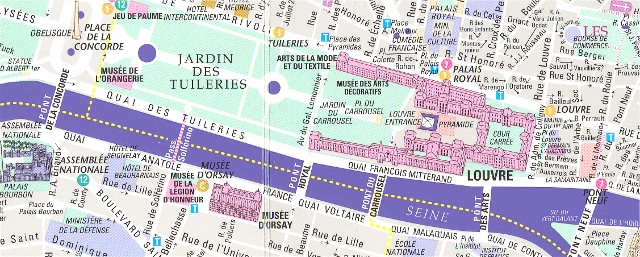
So our challenge for you are here now is simply this: to tastefully add the entire corpus of the world’s information related to tourism in central Paris (for instance) to this nice little accordion-fold map, while retaining the excellent characteristics that make it so fit for its purpose.
Let’s be clear what the electronic corpus will include.
1) Maps, and lots of ‘em. Antique maps, merely old maps, modern maps, aerial views. Real-time traffic maps, and historical maps showing the routes of kings, traders, warriors and vagabonds. Maps of weather and pollution and allergens and economic strata. Shopping maps and eating maps and literary maps. Wifi maps. Hotel vacancy maps. David Brin video surveillance maps. Maps showing the places that all your friends told you had (foie gras / chocolate / macaroons / chemises blancs) to die for.
2) Guides. Detailed curatorial guides to the Louvre, and every other musee, monument, neighborhood and cultural molehill in Paris. Wonderful guides with photos and voices and music and moving pictures, detailing the cultural milieu of the people, the places and the times. Most of the current guides for these places are pathetic, not for lack of trying, but because they can’t possibly provide enough breadth and depth in a free pamphlet. Even published museum catalogs, audio tours and tourist guidebooks barely scratch the surface. Of course they also don’t harness the local expertise of 10 million Parisians and many more millions of knowledgeable visitors, whereas our little application will.
3) Books. Poetry. Music. Paintings. Photographs. Letters. Magazines. Newspapers. Ephemera. Blogs.
4) Stories. Verlaine and Rimbaud’s, for example. The ones people tell at Jim Morrison’s grave, for example. Yours, for example.
And probably a lot more…stuff. Sort of like the web only more so, and with more metadata, geographical and otherwise. Hey, you might ask, where’s all that stuff going to come from? Don’t we have a monumental task ahead to digitize the world’s ancient maps, museum catalogs, 17th century music, and so forth? Well of course. So we’ll need a lot of grad students, and probably a few undergrads too. And don’t forget we have a pretty big sensor network infrastructure to design and deploy, for those nice real-time data feeds. Syndication & aggregation geeks take note, some interesting opportunities here.
How are we going to georeference and time-reference all of that stuff? Not sure, perhaps the semantic web folks have an opinion, or maybe it grows out of GeoURL or OpenGIS. But I do know that I want antique maps to overlay modern ones with accurate spatial & temporal registration, so we are going to need a well-known model for annotating them with the right metadata. Same goes for the rest of the corpus.
With all that amazing stuff rolling around inside, vous êtes ici maintenant is going to need a killer interaction model and interface to make it tractable for your basic human bean of average bandwidth and mental dexterity. I’m not sure what that will be, but I know it’s not WIMPs. Will we want translucent layers of data that modulate with finger pressure? Maps that orient automatically depending on how they are held? A huge information space navigated by tilting the map? Will the interface even be part of the map, or will we instead create personal interfaces that operate more generally on the connected world around us? Do we imagine fingertip sensors that provide a variety of pointing and gestural modes (index tap = select, middle = drag, ring = show related, pinky = google) on any arbitrary display appliance? Or what if it’s a voice interface – not speaking to the map, but speaking via instant voice messaging to a person that has collected the data and perspectives and expertise for you to tap into, related to the context you are in, delivered instantly in RSS?
And of course someone needs to sort out the technical issues implied by an 8.5” x 38” accordion-fold display appliance, or the moral equivalent thereof. Yes, I know a pocketable display that size will be hard. But this is starting to look like a twenty year project, so I’m hopeful that those thin flexible displays we’ve been promised will catch up by the time the rest of our stuff comes together. By then maybe we’ll also finally have wireless freenets with enough coverage and zorch to handle 10,000 simultaneous Da Vinci Code fanatiques poring over Leonardo’s sketchbooks, I.M. Pei’s architectural plans, and Ron Howard’s film version in the hall beneath the Pyramide.
Okay, there’s just a bit of work to do, so let’s quit reading the blogs and get on with it. I'm already thinking about my next trip to Paris ;-D
June 01, 2004
augmented reality at 30,000 feet
Catching up on nutritious boingboing nuggets from last week, I saw (and immediately amazoned!) this book Window Seat by Gregory Dicum.
Broken down by region, this unusual guide features 70 aerial photographs; a fold-out map of North America showing major flight paths; profiles of each region covering its landforms, waterways, and cities; tips on spotting major sights, such as the Northern Lights, the Grand Canyon, and Disney World; tips on spotting not-so-major sights such as prisons, mines, and Interstates; and straightforward, friendly text on cloud shapes, weather patterns, the continent's history, and more.
What a cool book concept, I'll take it along on my upcoming flight and let you know how it goes.
I've been thinking wishfully about a similar idea for a few years: an augmented reality thingy for air travel. Basically, a handheld or laptop style display synchronized to the view out your window, overlaid with geolocated information about the mysterious landscape below. Easy, prosaic map stuff like city names, rivers, mountain ranges, political borders. Fun, useless stuff like "who blogs down there?" Maybe even throw in some of Matt Jones' funky embodied versions of Tufte's sparklines, endless hectares of "squirming data" writ large across the terrain.
It wouldn't even be that hard to do, folks. Planes have all the location and altitude data you would need to get the projection matrix right for any given seat. Images are a bit trickier, but how hard could it really be to capture a database of clear-day pictures along the major routes? Pipe it all to an ethernet jack in my armrest, or just plop it onto that in-seat video screen if you must. I'd probably pay extra for it if that helps, are you listening United? Just don't seat me on the wing ;-)
[via boingboing]
April 05, 2004
prada epicenter revisited
We're always at least one step behind the times here at fredshouse, which is one reason why we're so endearing. But a February article in Business 2.0 (grumble, subscription req'd) chronicling "Prada's High-Tech Misstep" doesn't seem to have been widely discussed, and since I just saw it (via Thackara's newsletter) it's news to me.
You'll no doubt remember the Rem Koolhaas designed Prada Epicenter, a $40M Manhattan store that opened in Dec 2001 to much fanfare. With wireless custom PDAs, RFID tags in all the product linked to real time inventory and CRM databases, "smart" dressing rooms with Privalite liquid crystal glass walls, and clothes closets with touchscreens showing size/color/matching options along with videos of the selected items being catwalked, it was a ubicomp retail fantasy brought to life.
Fast forward two years later, and all is apparently not well at the epicenter:
Most of the flashy technology today sits idle, abandoned by employees who never quite embraced computing chic and are now too overwhelmed by large crowds to coolly assist shoppers with handhelds. On top of that, many gadgets, such as automated dressing-room doors and touchscreens, are either malfunctioning or ignored. The multimillion-dollar technology spend is starting to look more like tech for tech's sake than an enhancement of the shopping experience, and already the store's failings have prompted Prada to reevaluate its epicenter strategy.
Regarding the custom handhelds that the employees were to carry with them:
During multiple visits this winter, only once was a PDA spied in public -- lying unused on a shelf -- and on weekends, one employee noted, "we put them away, so the tourists don't play with them."
As for the RFID-reading clothes closets:
On several recent occasions, the RFID "closet" failed to recognize the Texas Instruments-made tags, and the touchscreen was either blank or broadcasting random video loops. During another visit, the system recognized the clothes -- and promptly crashed.
I'm not surprised that Prada's experience has been less than delightful. We did some large-scale demo systems and real-world user experiments in cooltown, and we discovered some serious challenges in deploying even relatively simple ubiquitous computing technologies.
One, what seems straightforward to build and run in the lab, is an order of magnitude harder to make work in the world. Using wireless LAN? Count on interference. Using infrared? Count on sunlight and heat sources. Using RFID? Count on damaged tags and misreads. Using PDAs? Count on dead batteries, lost styli, frequent crashes, both the soft and hard (floor) kind. Oh, and everything will be obsolete or broken in a year or two, so count on plenty of ongoing support to keep things fresh and fun.
Two, the real problem is those pesky humans that use the system. You try to make serious technology for serious business, and people just want to play with it, see what it does and what they can make it do that it wasn't designed to do. The novelty or "wow factor" of nomadic and ubicomp technologies is a significant issue for evaluating and deploying these kinds of systems. We saw this in our work with the Exploratorium, for example.
Three, the real problem is those pesky humans that use the system. The potential uses and benefits of ubicomp often seem "obvious"; most of us in the field have spun variations of the same futuristic scenarios, to the point where it seems like a familiar and tired genre of joke. "You walk into the [conference room, living room, museum gallery, hospital ward], the contextual intention system recognizes you by your [beacon, tag, badge, face, gait], and the [lights, music, temperature, privacy settings, security permissions] adjust smoothly to your preferences. Your new location is announced to the [room, building, global buddy list service, homeland security department], and your [videoconference, favorite tv show, appointment calendar, breakfast order] is automatically started." And so on. Of course, what real people need/want in any given situation is FAR from obvious. Even the simplest stuff is non-obvious: If the task you are supporting in your ubi-design requires people to use their hands, don't be surprised if they don't know what to do with that handheld computer you gave them! And if people are supposed to step on a floor pedal to turn the dressing room walls opaque (huh? I suppose that must have made sense to some designer?), don't be surprised when the rest of the store gets an unintended eyeful of prime Prada-buying primadonna.
Ubicomp is hard, understanding people, context, and the world is hard, getting computers to handle everyday situations is hard, and expectations are set way too high. I used to say ubicomp was a ten-year problem; now I'm starting to think that it's really a hundred-year problem. Prada took an audacious, fun step forward, but the journey has only just begun.
March 11, 2004
lindholm's lifeblog
The Beeb covers Christian Lindholm's LifeBlog project.
"The mobile telephone is becoming a life recorder," said Christian Lindholm, former head of user interfaces at Nokia and now the man behind the Lifeblog project."People are gatherers," he said, "somewhere deep in the genes there's something that tells us to collect stuff."
"I would like lifeblogging to become a verb. "
Here's a nice (but large, 10MB!) .ppt from his ETCon talk last month.
Christian is one of the big reasons why Nokia's handsets are nicer to use than any other personal devices, with the possible exception of the iPod. He invented the original Navikey, and led the design of the Series 60 UI; both of these are really great innovations. (But, umm, Christian, that circular keypad on the 3650, what was that all about? I love the style of it, but after nearly a year I still have to look at it when I text or dial...)
March 09, 2004
the future of cooperation
Q: "What is the most important learning or insight from your field about cooperation?"
A: "Cooperation and collective action will emerge spontaneously among people using electronic communications media, in rough proportion to the number of people connected by the medium, the level of openness or standardization in the underlying technical protocols of the system, and the ability of people to create and share the information content of the medium. Reed's Law suggests that value in "group forming networks" such as the Internet grows exponentially with the number of interconnected people in the network.
In the coming era of ubiquitous computing and communications, unprecedented cooperation among normally self-interested entities will be required to establish the required openness and standardization of the technical infrastructure."
Now playing: Lucinda Williams | Car Wheels on a Gravel Road | 2 Kool 2 Be 4-Gotten
February 26, 2004
froogle goes wireless
From those restless minds at google labs, here's the new Wireless Froogle. It's coded in WML, so your futurephone browser should lap it up like a dog loves spilled milk. I tried it out on my nokia 3650, it seemed to work fine although the product listings didn't have active links to the sites that were offering them. Maybe because those sites will be crap (at best) on a phone? Anyway, a fun little toy. The URL for your phone browser is http://wml.google.com.
Now all they need is something like a cameraphone barcode reader. This company mitigo was eaten by another outfit, international wireless corp, whose site is now also kaput. Guess this is an example of an obvious idea whose time has not yet come. Too bad, because google actually does a credible job of dereferencing barcode identifiers, especially the ISBN ones on books.
Just by the way, you can also get a tiny version of the main google engine suitable for your phone or wireless pda, at http://www.google.com/palm. Extremely useful for modern nomads.
February 11, 2004
a new social media thing
Ludicorp, who may someday release a production version of the mysterioso Game Neverending, has launched Flickr, a social-network-plus-image-sharing site. This should be interesting...
[via caterina.net]
February 04, 2004
a semantic earth?
David Weinberger has written a piece for Release 1.0 on GIS, location awareness, and the layering of semantic information over the physical coordinate system of the earth's surface; it's titled "The Semantic Earth", and he has posted the surprisingly poetic abstract on his blog.
"Thanks to the constellation of technology that enables digital networks to be laid over the places of the earth, wherever we are we will be able to hear the human conversation that has occurred about that place - the history that occurred there, the aesthetics to be savored, the commerce transpiring at that very moment, recommendations offered by strangers and friends. The mute places of the earth are being given voice, and the voices are, of course, ours. Meanwhile, the places themselves are becoming digitally alive and are noting our presence, too."
It's a tempting teaser, and I want to read more. Guess I'll have to see if any of my dear colleagues are still subscribers in these times of, er, fiscal responsibility. I don't suppose the article is published under a creative commons license, either.
Predictably, I'm curious because this is an area that my research group has been interested in for some time. For example, our work in creating digital representations for people, places and things led us to semantic location and the Websign project. There have been many other noteworthy efforts with a similar flavor, just to cite a few from research ("A Walk in the Wired Woods", Urban Tapestries, PlaceLab) and the web community (GeoURL, the Degree Confluence Project, GeoGraffiti, BlogMapper), and of course there's a mountain of related work in the digital mapping and GIS world. Useful, interesting, and/or provocative references and ideas can also be found in blogspace at starhillindex, Locative Media, IFTF, and Headmap to name just a few.
In this fascinating area, there are some questions that need to be raised, for example:
Will these geolocated information systems be open systems or closed? That is to say, will the specifications for creating and accessing georeferenced data be based on open standards and protocols? Will anyone be free to create georeferenced information and services? Or will a proprietary model be operative? Will Vodafone subscribers be able to experience the geo-stories written by AT&T subscribers? Will Smartphone-based devices only post in Windows Media format, leaving Symbian devices in the cold?
What legal framework will govern these systems? Does ownership of the surface real estate confer the ability to control what is posted in the "air" above it, or by whom it is posted? Can a company "own" its location coordinates in the same way it owns its domain name?
How will businesses use geolocation? Will location-based CRM and advertising become commonplace? Can we imagine a way that these can be delivered, that we won't find supremely annoying? What will this mean for individual privacy? Are we about to give our mobile operators the same level of access to our physical whereabouts, as Visa currently has about our spending patterns?
What will be the affordances of these systems? If there is information georeferenced at some place, how will I discover it? If there are thousands of different pages or services, how will I differentiate among them to find the ones most interesting to me? Will there be filters, editors, moderators? Or will location spam overwhelm the human conversations, the historical anecdotes, and the lovingly crafted travelogues?
What fun! I can't wait to read the article.
January 16, 2004
the onject-oriented world
Yesterday found me working up ideas for the "gloves off" post, typing fragmentary notes to expand on later. I was thinking about the idea of reading the digital representations of physical things by touching them, which led me to wondering about affordances that would communicate whether an object was 'live', meaning that it would have an accessible digital story to tell.
As fate would have it, I hit 'n' instead of 'b' and thus quite accidentally coined the oddly appropriate word "onject". Thinking this was too good to be true, I googled it. Amazingly, every citation that came back was either a one-key-displaced typo for "object", or more rarely for "inject". So it looks like this post will be the authoritative source of the new ubicomp term, "onject".
'on jekt : n. A tangible physical entity or object which also has a digital information representation, and which possesses the ability to communicate this digital representation to a person or another entity.
Heh.
November 05, 2003
the cybernomadic experience
Last week I attended a stimulating conference with the somewhat unwieldy title "Space, Place and Ubiquitous Technology: The Cybernomadic Experience", produced by the fine folks at the Institute for the Future. The central premise of the session was that the emergence of ubiquitous and connective technologies (our usual suspects such as wireless networks, physical and digital tagging, location and context awareness, personal and embedded devices, sensor nets, flexible displays etc) creates dislocations and transformations in the way we experience and interact with places and spaces in the physical world. Through research, observational work and analysis (some of which is nicely documented in raw form on this blog), IFTF developed a series of insights and implications which became the core material for the conference.
The IFTF team used a technique that I thought worked well. They created a series of artifacts from the future circa 2013, designed to highlight key observations from the research. For example, a nomadic mapping tool called "Mapgeste" provided a dynamic view into the resources, focal points and social overlays that its owner would find useful in a visit to San Francisco. The full presentation of seven artifacts is now posted here, and is worth a close look. The assumptions about technical feasibility in these scenarios are obviously debatable, but that's mostly beside the point. The goal was to identify interesting shifts in the social, economic and commercial landscape that result from new technologies applied in new ways.
Having worked on ubicomp technology research for several years, I find myself drawn increasingly to discussions like this conference. There is such a strong need for sensemaking, for building a pragmatic understanding of how the confluence of so many new technologies will play out in the social and physical architecture of our lives. In the deeply connected world there is great positive potential for the amplification of human abilities, and also great potential for social harm. We need to have some idea of what kind of world we are setting ourselves up for; I'm afraid 'que sera, sera' isn't a good enough answer.
Sony PSP concept pix
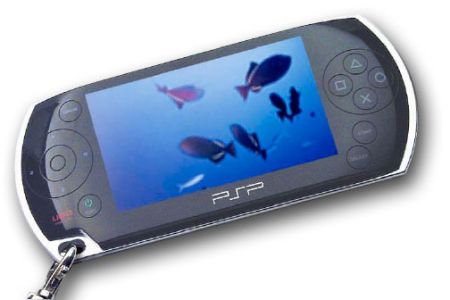
I originally put this on my behind the firewall site, but it's just gotta be here too...
First conceptual images of the Sony PlayStation Portable, expected to ship toward the end of 2004. If it actually comes out looking like this, it will be a pretty scrumptious piece of game gear. I wonder a bit about the ergonomics; experienced PS2 gamers will probably miss the secure grips of today's controllers, especially for those complicated combo sequences. But with 802.11, dual MIPS CPUs plus GPU, and the new Universal Media Disk format, it promises to be an interesting new platform.
[via good ol' Gizmodo]
Heh, and I see that boingboing has this too, with the only in Xeni-land headline "Gadgetgasm-inducing new products from Sony"!
October 22, 2003
pictures from ubicomp 2003
Some grainy cameraphone shots of random things I saw at Ubicomp 2003. I might try to explain some of these later.
October 15, 2003
some impressions of ubicomp 2003
I was going to write some moderately unkind things about Bill Mitchell's conference keynote "Me++: The Cyborg Self and the Networked City" (which turned out to be a plug for his new book of the same name), but Anne Galloway already speared him, so I just dropped a comment over there instead.
I'm still disappointed with the overall quality of Ubicomp. Although the accept rate for papers is quite low (<10% this year, I think), I feel the quality of the papers is nonetheless spotty. Arguably, this year's program was better than last year's, however, it was still well short of what we should be doing given such a rich and potentially world-changing field in which to work. This is even more puzzling to me, since I know that so many of the community are vitally creative, productive, and talented researchers. Hmm, need to think this one through...
October 14, 2003
fun with noderunner and netstumbler
We played noderunner today in Seattle. Noderunner is a fun game where two teams go out in the streets with wifi devices and cameras, searching for open wireless access points. The object is to find an open AP, take a photo of the location, and email the photo from that wireless node, back to your team's photoblog. The team with the most valid APs found and used, wins.
It was a lot of fun even though my team lost. There are so many access points out there, literally hundreds within a few blocks of the Westin. I downloaded Netstumbler as we were walking out the door so I could see the nodes more easily, it's a pretty nice little tool. But I guess people have heard enough about security, so most APs we saw were locked down.
Noderunner was created by folks from NYCwireless and Eyebeam. The big dream is to get free, open wireless coverage to emerge in cities, and the game is one way to raise visibility for this hopeful vision. I agree with this; in the long run, it seems that 'venues' should no more charge people for using their wireless than they would for use of their air conditioning or their electricity. We have a long way to go though.
October 12, 2003
on the bus
Literally, I'm on the bus from Sea-Tac to the Westin. No hotspots in view, but the trusty GPRS card in the tablet is getting some traction as we roll down whatever freeway this is. Now *this* is moblogging!
Tim Oren finally blogged his view of Silicon Valley 4.0, and as usual he's got a worthwhile opinion. As the title says, "You never know where you're going 'til you get there."
Oops, gotta go, bus stop.
September 30, 2003
new wireless data services
Verizon Wireless officially launches its new high speed 1xEV-DO data service tomorrow. While the service promises DSL-like downstream speeds of 300-500Kb/s, the rollout is initially limited to the DC area and around San Diego.
AT&T Wireless can't be far behind; they have been promising an EDGE-based service by the end of 2003. At 100-300Kb/s EDGE will be slower than the VZW EV-DO network, but since it is a relatively straightforward (mostly software) upgrade from the current GSM/GPRS system, ATTWS may be able to reach nationwide coverage rapidly.
Meanwhile, I'm turning blue holding my breath for these guys. Get me more bandwidth, *stat*! Oh, and can we please get a consumer class data plan, folks? It seems like the magic price point for all you can eat wireless is $79.99/month no matter what. Today's Sprint PCS and ATTWS GPRS both clock in at 80 bucks for modem rates. Verizon's EV-DO will be $80, but so is it's slower 1xRTT network everywhere else. I understand T-Mobile's GPRS is cheaper, but this doesn't seem to influence the other big players. Go figure. High speed wireless WAN is going to change the game, but eighty dollars is Too Much Money :-P
Oh, and here's something to ponder: when almost-DSL speed is widely deployed and when the price drops down to a more palatable level, say $40/month flat rate, what will happen with hotspots? Hrm, well, that's actually a can of worms because there are a number of forces at play and the answer is potentially quite complicated. But it seems to me that unless we start to see popular services that eat large amounts of bandwidth, public WLAN hotspot operators may find themselves marginalized by WWAN. Hotspot business models that depend directly on subscriber revenue may be even tougher nuts to crack than they already are. If it works out that way it's okay by me, since I think hotspots should be free (as in free lunch) in any case.
Remind me to look at DC and SD in six months to see how it's playing out. Actually, it would be worth looking at S. Korea where they already have widespread 1xEV and hotspots; the Koreans are Net Crazy.
September 25, 2003
pretty cool lifestyle toys from Nokia
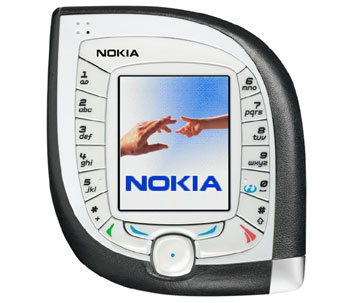

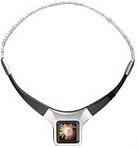

Nokia has just announced several interesting devices, including a style-driven cameraphone with both WCDMA and GSM, two digital pictureframes, two versions of wearable display medallion, and an odd little photo viewer that works like a kaleidoscope. Neat stuff, but no pricing available yet.
So:
- more proof that phones are fashion, and that ain't corinthian leather, folks
- infrared still isn't dead, how about that?
- weird keyboard layouts that suck aren't dead
- wearable picture frames are going to be pretty funny
I wonder how does Nokia get these things out of the lab and into the market?
September 10, 2003
Sony's new Aibo ERS-7
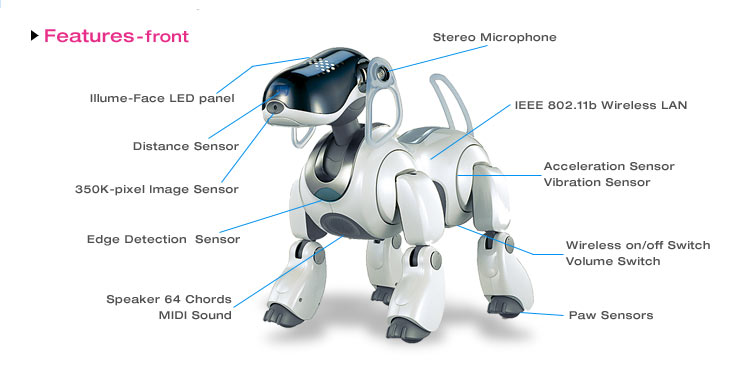
I'm a sucker for these things. Not enough of one to have actually bought an Aibo, but there's still time for that. It's definitely on my list of objects of desire.
It's great that Sony has found a way to bring some of its ubicomp, robotics and interaction research to market, in a fun and buzz-generating fashion. Aibo is one of the most sophisticated networked sensor platforms I've seen outside of research, incorporating imaging, audio, tactile, motion and physical environment sensing along with rudimentary pattern rec and voice rec. Of course, it's also a computer with WLAN, photo capture, and email. Not sure if it's a web server as well, but that would make a lot of sense. The Aibo development team must be having a ton of fun :-D
It's not a very good dog, but it's an incredibly evocative ubi-object.
(via KoKoRo)
August 14, 2003
blah blah
I did an interview on M2M (machine to machine) technologies for this consulting company Focal Point, guess it got published (URL will probably break soon, doh). Mostly the corporate technostory, but I got to say a bit about moblogging ;-)
"Personal mobile devices are going to continue integrating communication, computing, imaging and sensing technologies at a rapid clip. My phone today has a decent VGA camera, captures audio, stills and video, does MMS, 2D games, Java, IR, Bluetooth, and stores 256MB, and that's not even the state of the art. With a few button pushes, I can publish text and multimedia to my personal weblog in almost real time. I'm guessing that significant volumes of devices will integrate WAN and WLAN, streaming media, GPS, tag sensing, biometrics and other features within 2-3 years, at which point the services will start to get very interesting."

